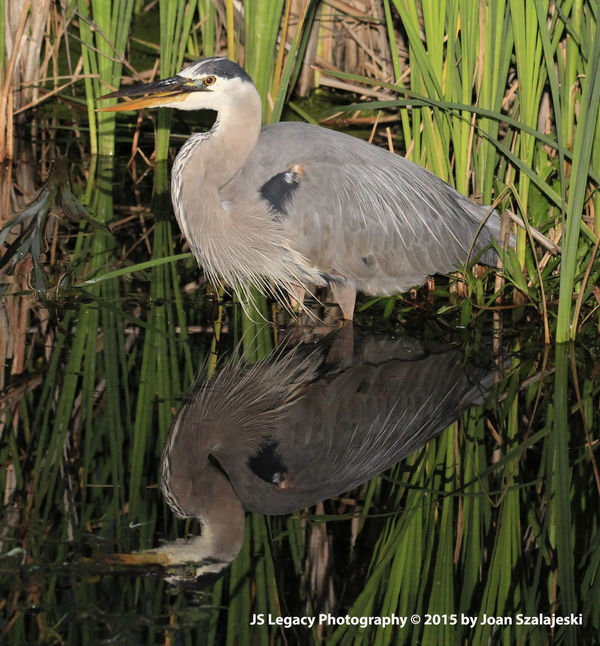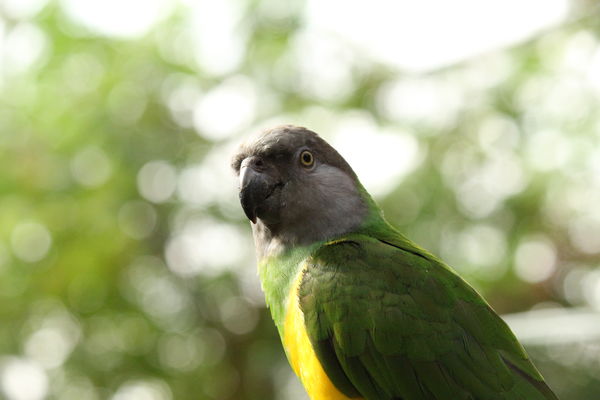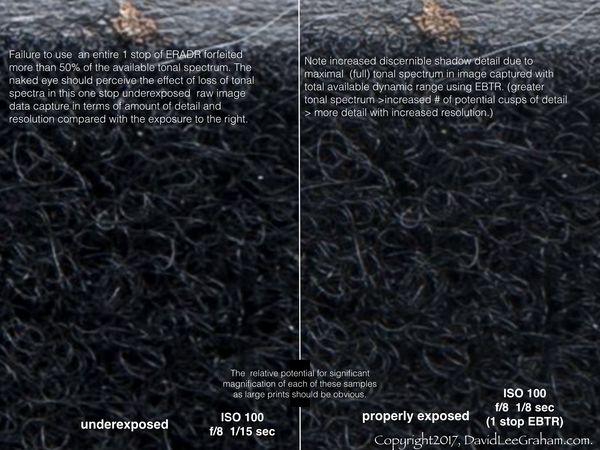What SOOC proponents don't seem to understand
Apr 23, 2017 11:32:17 #
TheDman
Loc: USA
Uuglypher wrote:
The basis of proper exposure of raw image data is to expose for the brightest image possible without clipping highlight detail, but coming as close to clipping as possible without actually doing so.
The basis of proper exposure of raw image data is to expose for the brightest image possible without clipping highlight detail, but coming as close to clipping as possible without actually doing so.
That's not what I try to do, as the highlights look like crap if you push them up to the bleeding edge and then try to recover them.
Apr 23, 2017 11:52:26 #
TheDman wrote:
That's not what I try to do, as the highlights look like crap if you push them up to the bleeding edge and then try to recover them.
Hi, Dman,
I'd not expect detail to be rendered by a "bleeding edge" saturated photosite...In my experience that's a specular highlight. With tonal normalization in A.C.R. (my raw converter-of-choice) the less-than-saturated photosites render as desired.
In my experience the adage "Your mileage may vary" strongly applies.
Best regards,
Dave
Apr 23, 2017 11:55:20 #
TheDman
Loc: USA
Uuglypher wrote:
Hi, Dman,
I'd not expect detail to be rendered by a "bleeding edge" saturated photosite...In my experience that's a specular highlight. With tonal normalization in A.C.R. (my raw converter-of-choice) the less-than-saturated photosites render as desired.
In my experience the adage "Your mileage may vary" strongly applies.
Best regards,
Dave
I'd not expect detail to be rendered by a "bleeding edge" saturated photosite...In my experience that's a specular highlight. With tonal normalization in A.C.R. (my raw converter-of-choice) the less-than-saturated photosites render as desired.
In my experience the adage "Your mileage may vary" strongly applies.
Best regards,
Dave
We not talking about specular highlights, we're talking about pushing highlights to the maximum possible without blowing them out, as you said. That produces poor results compared to nailing the highlight exposure, as the video showed.
Apr 23, 2017 12:50:42 #
SOOC is the raw material for future consideration in post processing. Some images need it others not. With our modern digital cameras we have a number of things to diddle with beyond shutter, aperture (film speed dial just fixed a parameter that enabled shutter and aperture could work in tandem). Now you have things like color balance, HDR, etc to play with - sort of like a pre post process.
Apr 23, 2017 13:19:32 #
TheDman wrote:
We not talking about specular highlights, we're talking about pushing highlights to the maximum possible without blowing them out, as you said. That produces poor results compared to nailing the highlight exposure, as the video showed.
Obviously, our experiences differ. the basic premise that I stated for raw image data capture is certainly not original with me. As a film photographer since the late 1940s who converted to digital at the last turn-of-century I read and paid particular attention to a number of digital exposure pioneers..Tried a wide variety of recommendations, and the advice of .John Knoll, Bruce Fraser, Jeff Schewe, and Martin Evening gelled in agreement and, to my eye for results, rose to the top, and I've not been let down by it nor, with added experience, have I found objective reason to follow some other paradigm of exposure.
I have found that the various proprietary raw converters differ widely in their abilities to handle close-to-saturation photosites, and have settled on Adobe Camera Raw as the hands-down superior raw converter in that regard.
We all do the best as we determine by our own lights.
Thanks for your perspectives.
Dave
Apr 23, 2017 13:30:15 #
ebbote wrote:
So Toby, what your are saying is that PP is a must... (show quote)
I started this thread not to try to convince the SOOC faithful to change horses, but rather to point out to a lot of people who are starting out not to put too much stock in the claim of some of them that somehow one is not a "true" or "good" photographer if s/he has to post process an image.
Let me make it clear: I am all for getting it right in the camera. As the old computer guys say, "garbage in, garbage out." However for me "right" depends on my knowledge of what I can eke out of an image in post. If I am in a high DR situation, with a lot of highlights, I will make sure those highlights are recoverable. That often means seriously underexposing an image. It will look dark as a dungeon SOOC, but once I tweak it in a good editor I will get my midtones in the right place, have shadow detail without too much noise, AND have detail in the highlights.
If I expose for midtones--to get them looking "right" SOOC, I will have blown the highlights and possibly also have crushed shadows. It is also true that in the majority of shooting situations SOOC will cover the dynamic range of the scene, and highlight or shadow problems will not be a major issue.
If SOOC works for people I have no desire to put them through the ringer or blame them. Everybody should do what pleases and satisfies them. I just want to point out, to those who might benefit from the knowledge, the limitations of SOOC and what they might gain by taking the next step in the craft.
"Technique is the gauge of the sincerity of an artist"
~Ezra Pound
Apr 23, 2017 13:43:17 #
Uuglypher wrote:
The SOOC preference is held predominantly by those... (show quote)
Hi Dave,
I totally agree with this, but want to add one important point: We can only shoot to the edge of clipped highlights when we have the time to measure those highlights and they are not changing. In the real world, when shooting moving objects in time-critical situations, that is not practical. Therefore for some of us, the point is to have the headroom available that will save the majority of our shots. The trade off is a bit more noise but saving a whole bunch of good images that make editors happy, pay some bills and get us rehired. I honestly could care less if I add a stop's worth of noise to an image, especially if it saves the detail in some VIP's white shirt or dress.
Apr 23, 2017 14:23:13 #
TheDman wrote:
That's not what I try to do, as the highlights look like crap if you push them up to the bleeding edge and then try to recover them.
Isn't the problem really that if 1 or 2 channels have blown then there is no way to recover the original color, you can't recover what isn't there. In a situation like that you might be better to drop the color and process as black & white as the tonal information shouldn't be too tatty.
Apr 23, 2017 15:17:04 #
Apr 23, 2017 16:07:40 #
Yes: "In fact, one of the primary uses of editing software is to 'fix' bad pictures. How successful you are is mostly dependent on your editing skill."
BigDaddy wrote:
Much less "inane" than the statement to which it responded: "No amount of processing will fix a bad picture"
There are literately billions of once "bad" pictures around "fixed" with post processing. In fact, one of the primary uses of editing software is to "fix" bad pictures. How successful you are is mostly dependent on your editing skill.
There are literately billions of once "bad" pictures around "fixed" with post processing. In fact, one of the primary uses of editing software is to "fix" bad pictures. How successful you are is mostly dependent on your editing skill.
Apr 23, 2017 16:20:59 #
kymarto wrote:
Hi Dave, br I totally agree with this, but want to... (show quote)
Hi, Toby,
I understand your point completely.
In fact, my two cameras that get most use each have one and 2/3 stops of extra raw-accessible DR (ERADR) that hold fast from ISO 100 through ISO 400 which covers the great majority of my needs. I'm really not anal about it, so I use that last 1/3 stop as cushion and thus can explicitly rely on the remaining one and 1/3 stops to guarantee-damn-tee no clipping! It makes life incredibly easy while allowing me to reap the benefits of that extra one and 1/3 stop...that often embraces at least 75% if not more of the entire image file! IMO that made the small amount of time initially spent determining the ERADR of each camera well worth the effort.
Here's an example of the difference that using just one brighter stop of exposure can make in doubling the tonal spectrum of the capture with the consequent doubling of cusps of detail, in turn resulting in increased definition/resolution of deep shadow detail...which obviously has great impact on permitting increased print size (which, in the end can let the most persnickety pixel peeper to put off pronouncing on his standard preferred complaints until getting much closer than normal viewing distance (NVD) ). Please examine the download.
There is no question that increased tonal spectrum is of no particular benefit in the brighter end of the histogram, but it certainly pays off in the somber end!
Best Regards,
Dave
Apr 23, 2017 17:22:12 #
Apr 23, 2017 17:44:48 #
Tom G
Loc: Atlanta, GA
frankie c wrote:
AMEN 

This horse has now been soundly beaten to death, so I suggest all you "experts" let it Rest In Peace.
And, Kymarto, if Ezra Pound did indeed say, "Technique is the gauge of the sincerity of an artist", he was given far more praise than he deserved, for such an insipid remark. It shows the Pound knew even less about art than he knew about fascism.

Apr 23, 2017 19:04:56 #
Szalajj
Loc: Salem, NH
There are times when you NEED to Post Process, and times when you don't need to Post Process!
The first two shots were the SOOC, then the rescued version of the first shot.
The third shot is a Non-edited SOOC shot. And yes, technically the boken background is a little burned out, but at the time, I couldn't use any editing software due to a hardware failure on my old laptop. If I was to edit the last shot, I would try to darken the background a little
The first two shots were the SOOC, then the rescued version of the first shot.
The third shot is a Non-edited SOOC shot. And yes, technically the boken background is a little burned out, but at the time, I couldn't use any editing software due to a hardware failure on my old laptop. If I was to edit the last shot, I would try to darken the background a little
F 7.1 1/60 ISO 1600

(Download)
Edited, Cropped, and Copyrighted

(Download)
F 9.0 1/640 ISO 3200

(Download)
Apr 23, 2017 19:20:44 #
TheDman
Loc: USA
Uuglypher wrote:
Hi, Toby, br I understand your point completely. b... (show quote)
Or you can just shoot an exposure for the shadows and have more dynamic range than you can handle, all of it clean as a whistle. That way you can wallpaper a bus!
If you want to reply, then register here. Registration is free and your account is created instantly, so you can post right away.






